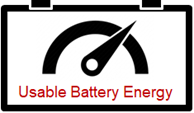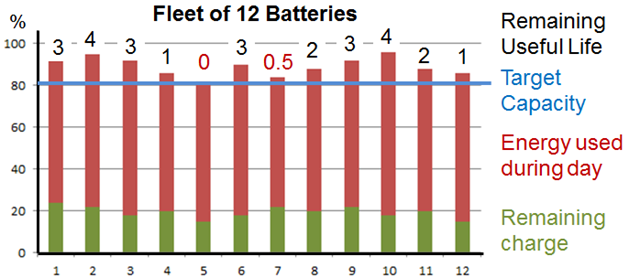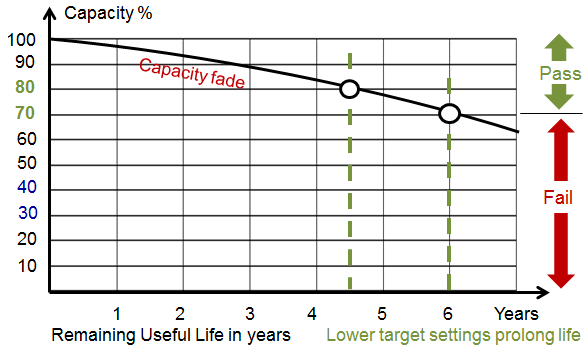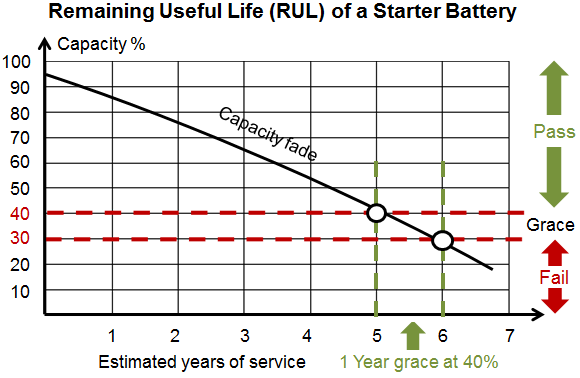Newsletter - April 2023
With governments pushing electrification despite immature technologies, battery diagnostics is gaining importance. Diagnostics involves revealing "Usable Battery Energy," a performance assessment that becomes essential as battery fade often goes unnoticed. While new batteries are developed from lab-to-market, Cadex complements manufacturers by caring for batteries from workforce-to-retirement by providing risk management.
Usable Battery Energy

Figure 1: Diagnostic includes knowing Usable Battery Energy
As batteries advance from portable usage to drive-trains in propulsion systems, the Usable Battery Energy must be known to reach the destination. UN and EU regulators are working on battery state-of-health (SoH) standards with accuracy requirements of 95%. Safety is also addressed; necessities that are not yet supported by mature technologies.
When asking battery users, "At what capacity do you replace your battery?" most get confused and reply, "I beg your pardon."
To ensure reliable service and set fair warranty claims, the minimal acceptable battery capacity is commonly set to 80%. The Cadex battery analyzers include the Target Selector that passes batteries on a set capacity target. This feature is also offered in the Supervisor chargers servicing SMBus batteries.

Figure 2: The Cadex Cloud makes battery fleets transparent
With Cadex Cloud, next-gen products will display the remaining charge of a battery before charge, together with the energy consumed, total available capacity, and RUL. The data is shown on a PC and provides invaluable insight into a battery fleet to assist in performance evaluation. Batteries that chronically return with low charge demand a higher target setting to increase the energy threshold. High charge reserve, on the other hand, enables setting the target lower to keep batteries in service longer.
Remaining Useful Life

Figure 3. Predictive behavior assesses RUL
Usable Battery Capacity only serves halfway; we also need to assess RUL. Cloud analytics predict user patterns and suggest an ideal target setting to assure sufficient charge reserve at the end of a day. User patterns take energy draw into account that differs from steady consumption in a patient monitor in healthcare, predicted scanner in warehouses, and power tools on an eight-hour shift on an assembly line. Lower predictions occur with batteries kept on standby for emergencies and sporadic missions.

Figure 4: RUL based on capacity, the leading health indicator.
Assessing RUL is also critical for starter batteries in vehicles. The main purpose is cranking the engine that draws up to 300A for a short time. In a starter application, the capacity can go low and still have enough energy to crank the engine.
The Spectro™ battery tester set the pass/fail threshold at 40%. Passing typically gives one year grace to the next service during which the starter battery may drop to 30%, still with strong cranking. Replacement will be necessary because a capacity below 30% does not assure reliable cranking.
Conclusion
Cadex is pioneering in Diagnostic Battery Management (DBM) to care for batteries from workforce to retirement. Battery diagnostics have been lagging behind other technologies. Assigning new duties to the battery demands performance transparency that is comparable with traditional energy sources by knowing the Remaining Useful Life. While the Battery Management System (BMS) provides valuable peripheral readings on battery condition from the outside-in, BMS alone cannot assess battery capacity serving as a leading health indicator. Scanning a battery from the inside-out with electrochemical impedance spectroscopy (EIS) promises a solution by combining test results.
